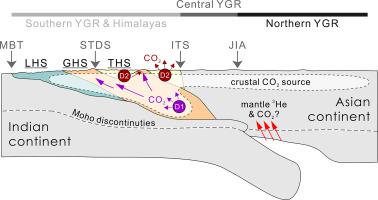Chemical Geology ( IF 3.6 ) Pub Date : 2021-09-23 , DOI: 10.1016/j.chemgeo.2021.120534 Maoliang Zhang 1 , Lihong Zhang 2 , Wenbin Zhao 3 , Zhengfu Guo 3 , Sheng Xu 1 , Yuji Sano 1, 4, 5 , Yun-Chao Lang 1 , Cong-Qiang Liu 1 , Ying Li 6

|
Extensional rift systems provide important pathways for the release of large amounts of deeply-sourced CO2 into the atmosphere. Continental rifting zones (e.g., East African rift) are thus invoked to be important for understanding the links between CO2 outgassing and global climate change associated with continental breakup. However, deeply-sourced CO2 emissions from extensional rift systems in continental collision zones remain poorly understood. Here, we focus on hydrothermal CO2 emissions from the southern segment of the Yadong-Gulu rift (YGR), the largest extensional rift in southern Tibetan Plateau, aiming at delineating rift-related CO2 emissions from the India-Asia continental collision zone. In-situ measurements of diffuse soil CO2 emissions indicate that average soil CO2 fluxes from the Kangbu, Mengzha, and Chaduo hydrothermal fields are 40, 700, and 255 g m−2 d−1, respectively. Combined with average soil CO2 fluxes (20–437 g m−2 d−1) from central and northern YGR, we speculate a relatively steady-state CO2 degassing pattern for the entire rift. The magnitude of soil CO2 fluxes of the YGR is higher than that of representative areas of the East African rift system. Evidence from 3He/4He reveals a pure crustal origin for CO2-bearing fluids in southern YGR, while the involvement of mantle CO2 is recognized in the central and northern rift segments. We suggest that metamorphic decarbonation of crustal rocks at variable depths is the primary cause for CO2 origin in southern YGR, which differs from the magma‑carbonate interaction model of central and northern YGR. Ternary mixing calculation based on He-CO2 systematics of hydrothermal gases indicates dominant contributions from carbonate rocks to total carbon inventory, with mantle CO2 contributions absent in southern YGR but discernible in northern YGR. The characteristic high proportions of crustal CO2 (>90%) distinguish the YGR from extensional rifts fed primarily by mantle CO2 in continental rifting zones. Our results reveal a crustal-scale carbon cycle in accretionary wedge of the India-Asia continental collision zone, together with magmatic front setting of the central and northern YGR, outlining a transect of the rift-related CO2 emissions across continental collision zones. This would contribute to better understanding the role of continental assembly in deeply-sourced CO2 emissions and global carbon budget.
中文翻译:

青藏高原亚东-古鲁裂谷南部变质二氧化碳排放:对印度-亚洲大陆碰撞区深部碳循环的洞察
张性裂谷系统为大量深源CO 2释放到大气中提供了重要途径。因此,大陆裂谷带(例如,东非裂谷)被认为对于理解 CO 2释气与与大陆分裂相关的全球气候变化之间的联系很重要。然而,大陆碰撞区伸展裂谷系统的深层CO 2排放仍然知之甚少。在这里,我们重点关注青藏高原南部最大的张性裂谷亚东-古鲁裂谷(YGR)南段的热液 CO 2排放,旨在描绘与裂谷相关的 CO 2来自印度-亚洲大陆碰撞区的排放。扩散土壤CO 2排放的原位测量表明,来自康布、蒙扎和乍多热液田的平均土壤CO 2通量分别为40、700和255 g m -2 d -1。结合来自 YGR 中部和北部的平均土壤 CO 2通量(20-437 g m -2 d -1),我们推测整个裂谷的CO 2脱气模式相对稳定。YGR的土壤CO 2通量的大小高于东非裂谷系统的代表性区域。来自3 He/ 4 的证据他揭示了YGR南部含CO 2流体的纯地壳起源,而在中部和北部裂谷段发现地幔CO 2的参与。我们认为不同深度地壳岩石的变质脱碳作用是南黄河带CO 2成因的主要原因,这与黄河带中北部岩浆-碳酸盐相互作用模型不同。基于热液气体的He-CO 2系统学的三元混合计算表明碳酸盐岩对总碳库的贡献占主导地位,在 YGR 南部没有地幔 CO 2贡献,但在 YGR 北部可辨别。地壳CO 2的特征性高比例(>90%) 将 YGR 与大陆裂谷带中主要由地幔 CO 2供给的张性裂谷区分开来。我们的研究结果揭示了印度-亚洲大陆碰撞区增生楔中的地壳尺度碳循环,以及 YGR 中部和北部的岩浆锋设置,勾勒出大陆碰撞区与裂谷相关的 CO 2排放的横断面。这将有助于更好地了解大陆组装在深源 CO 2排放和全球碳预算中的作用。











































 京公网安备 11010802027423号
京公网安备 11010802027423号